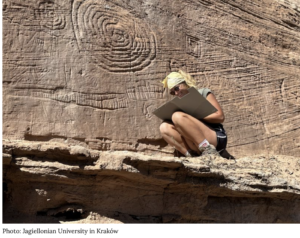 Archaeologists from the Jagiellonian University, southern Poland, have made a significant discovery of ancient indigenous paintings and carvings in the US state of Colorado-Utah border.
Archaeologists from the Jagiellonian University, southern Poland, have made a significant discovery of ancient indigenous paintings and carvings in the US state of Colorado-Utah border.
This Polish team has been exploring the area for over a decade, unraveling the mysteries of the 3000-year-old Pueblo culture.
Leading the research since 2011, Radosław Palonka, a professor at the Jagiellonian University and a specialist in New World archeology, says the findings dramatically alter the understanding of settlement in the area. His team is the only Polish and one of the few European archaeological groups to work in the region.
 The research is carried out at the Castle Rock Pueblo settlement complex, located on the picturesque Mesa Verde plateau on the border between Colorado and Utah. These areas are popular not only with archaeologists but also with tourists, because of the famous Pre-Columbian settlements built in rock niches or carved into canyon walls as well as numerous works of rock art created by members of the ancient Pueblo culture, which dates back to nearly 3 thousand years ago and is still present almost exactly in the same area.
The research is carried out at the Castle Rock Pueblo settlement complex, located on the picturesque Mesa Verde plateau on the border between Colorado and Utah. These areas are popular not only with archaeologists but also with tourists, because of the famous Pre-Columbian settlements built in rock niches or carved into canyon walls as well as numerous works of rock art created by members of the ancient Pueblo culture, which dates back to nearly 3 thousand years ago and is still present almost exactly in the same area.
The discoveries of his team include previously unknown huge galleries and petroglyphs dated to various historical periods. The oldest of them, showing warriors and shamans, are estimated to date back to as early as the 3rd century AD, the period known as the Basketmaker Era. They were engaged in farming and produced characteristic baskets and mats. Most petroglyphs come from the 12th and 13th century.
These petroglyphs were used for astronomical observations and calendar determinations during the thirteenth century, uncovering new information on the population size and religious practices of the Pueblo people.


- Article and photos courtesy of Jagiellonian University in Kraków
